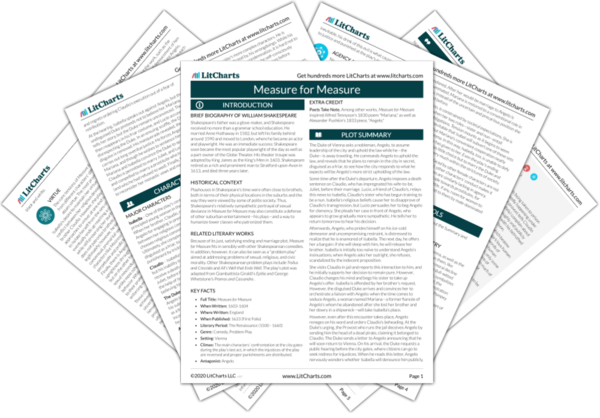Brief Biography of William Shakespeare
Shakespeare's father was a glove-maker, and Shakespeare received no more than a grammar school education. He married Anne Hathaway in 1582, but left his family behind around 1590 and moved to London, where he became an actor and playwright. He was an immediate success: Shakespeare soon became the most popular playwright of the day as well as a part-owner of the Globe Theater. His theater troupe was adopted by King James as the King's Men in 1603. Shakespeare retired as a rich and prominent man to Stratford-upon-Avon in 1613, and died three years later.
Historical Context of Measure for Measure
Playhouses in Shakespeare's time were often close to brothels, both in terms of their physical locations in the suburbs and the way they were viewed by some of polite society. Thus, Shakespeare's relatively sympathetic portrayal of sexual deviance in Measure for Measure may also constitute a defense of other suburban entertainment—his plays—and a way to humanize lower classes who patronized them.
Other Books Related to Measure for Measure
Because of its just, satisfying ending and marriage plot, Measure for Measure fits in sensibly with other Shakespearean comedies. In addition, however, it can also be seen as a "problem play" aimed at addressing problems of sexual, religious, and civic morality. Other Shakespearean problem plays include Troilus and Cressida and All’s Well that Ends Well. The play's plot was adapted from Giambattista Giraldi's Epitia and George Whetstone's Promos and Cassandra .
Key Facts about Measure for Measure
-
Full Title: Measure for Measure
-
When Written: 1603-1604
-
Where Written: England
-
When Published: 1623 (First Folio)
-
Literary Period: The Renaissance (1500 - 1660)
-
Genre: Comedy, Problem Play
-
Setting: Vienna
-
Climax: The main characters’ confrontation at the city gates during the play’s last act, in which the injustices of the play are reversed and proper punishments are distributed.
-
Antagonist: Angelo
Extra Credit for Measure for Measure
